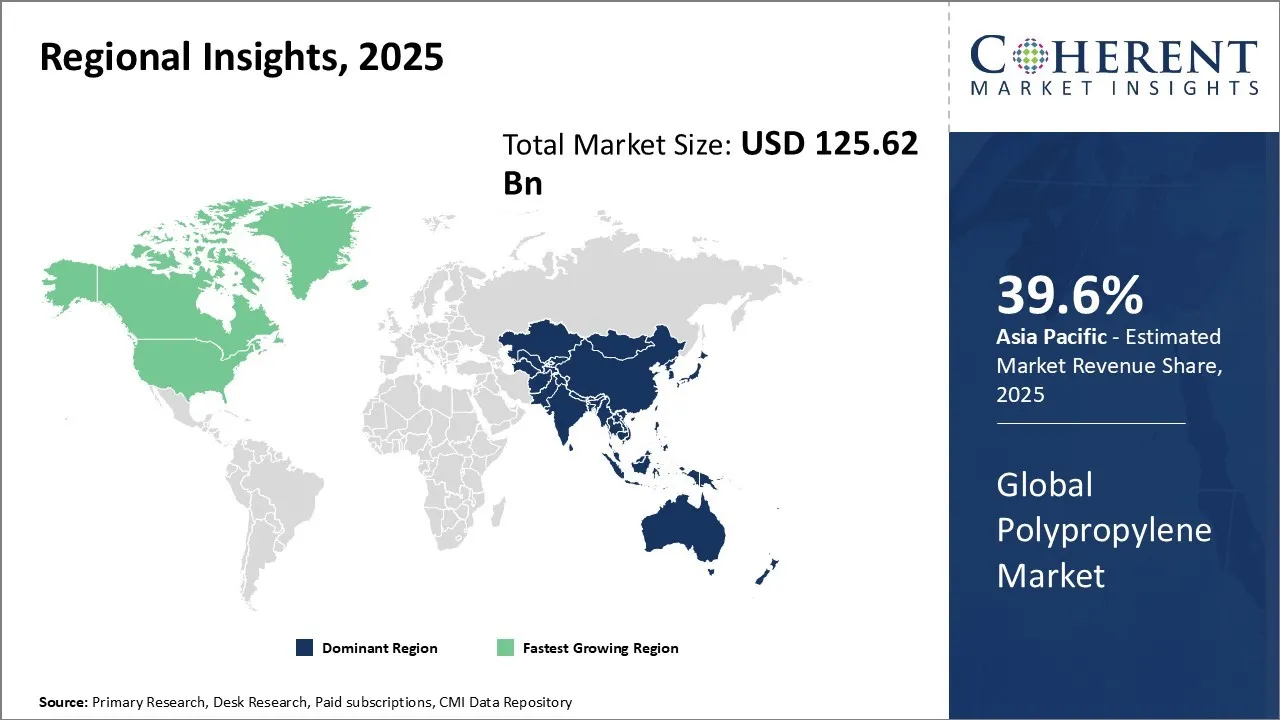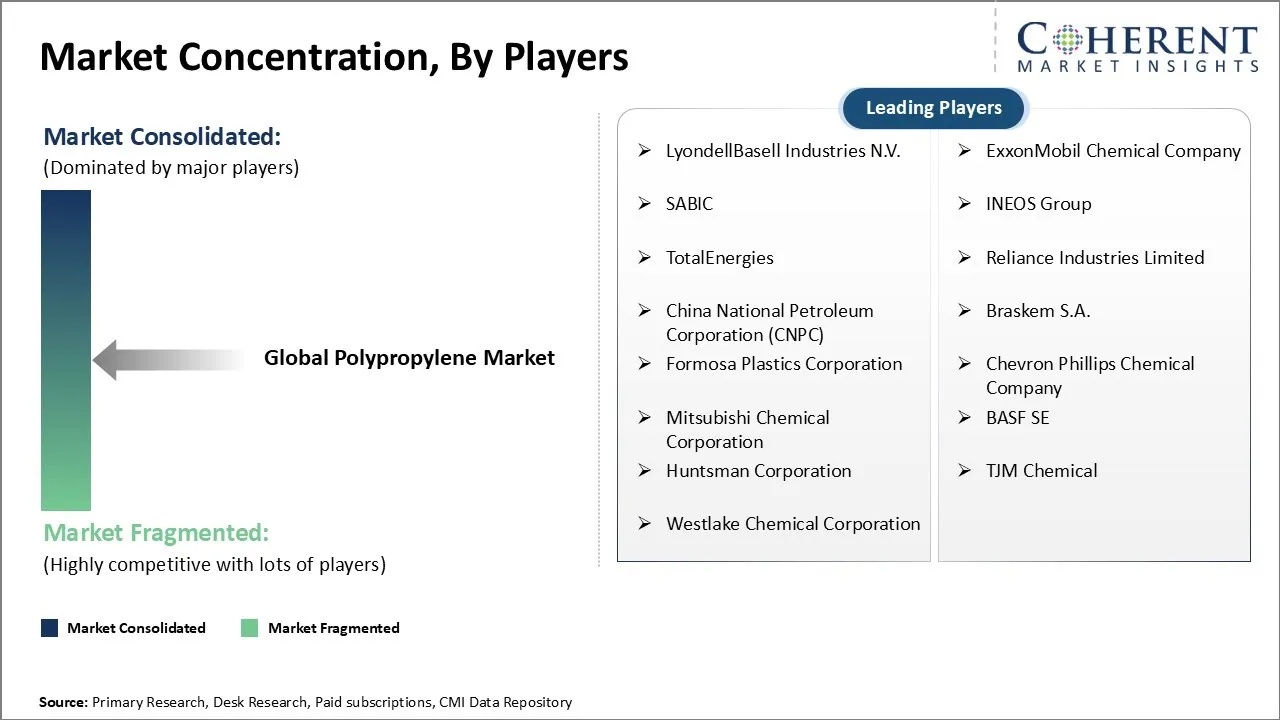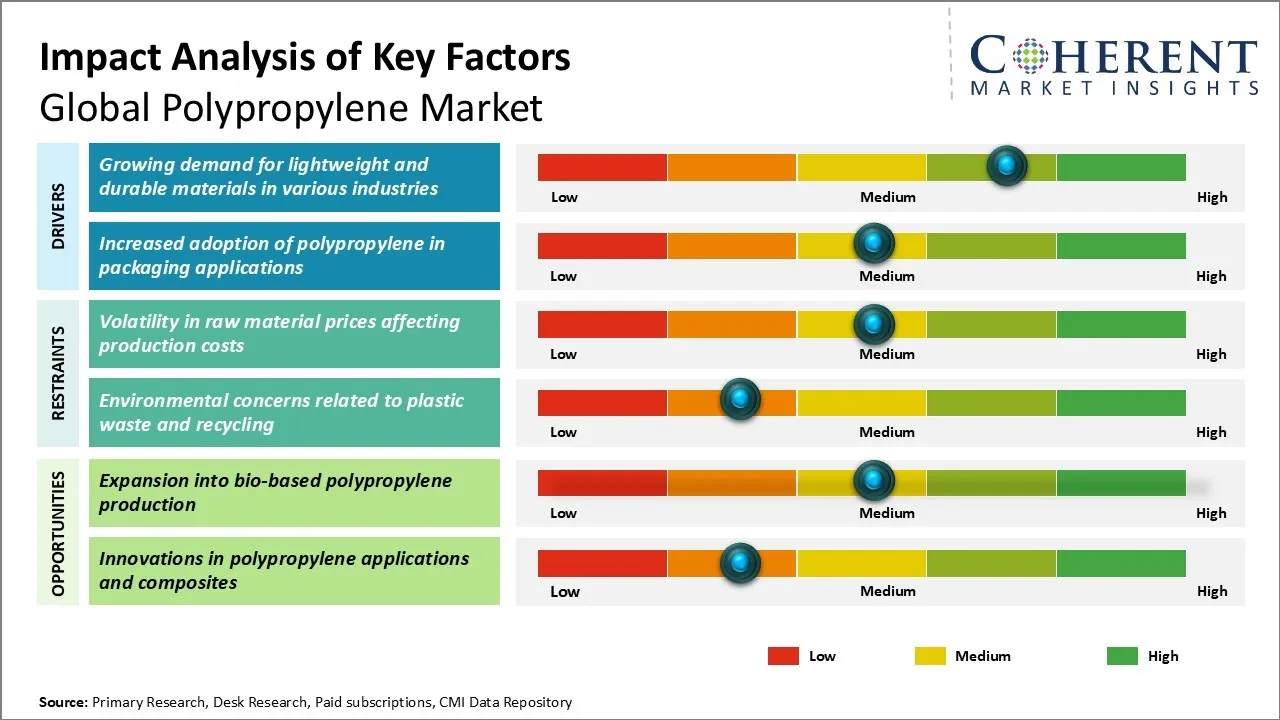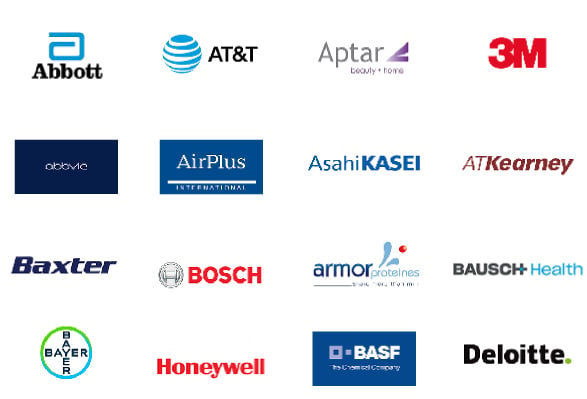The global polypropylene market is estimated to be valued at USD 125.62 Bn in 2025 and is expected to reach USD 173.54 Bn by 2032, exhibiting a compound annual growth rate (CAGR) of 4.7% from 2025 to 2032.
Key Takeaways of the Polypropylene Market:
Market Overview:
Polypropylene is widely used in various industries like packaging, automotive, construction, consumer goods, medical, etc. due to its properties such as resistance to corrosion and chemicals, mechanical, and thermal stability. Growing demand from the packaging industry especially for food packaging is expected to drive the market growth. The increasing usage of polypropylene in the automotive industry owing to its light weight and thermal resistance properties suitable for under the hood components is also supporting the market growth. In the construction sector, polypropylene is being increasingly utilized for manufacturing pipes, windows, and doors applications which is further expected to positively impact the market growth during the forecast period.
Type Insights - Technological Advancements Drive the Homopolymer Segment Growth
In terms of type, the homopolymer segment is estimated to contribute 62.3% share of the market in 2025, owing to its widespread application across various industries and continuous technological advancements resulting in improved properties. Homopolymer finds extensive use in the injection molding of rigid packaging for food and consumer goods due to its high stiffness, tensile strength, and low cost. Ongoing developments towards expanding the applications scope of homopolymer through property enhancement have propelled its demand. Major players are focusing on introducing grades with added functionality like barrier properties and compatibility with printing inks to replace conventional packaging materials.
Process Insights - Increased Automation Favors the Injection Molding Process
In terms of process, the injection molding segment is estimated to contribute 52.5% share of the market in 2025, owing to higher automation and mass production capabilities. Injection molding process offers tight dimensional tolerances, repeatability, and ability to mold complex parts quickly at reduced costs. This has enabled its widespread usage for manufacturing short-run as well as mass-produced consumer and industrial products. The continued automation of injection molding equipment with features such as integrated robots for part removal has augmented production efficiency.
Application Insights - Superior Properties Stimulate Fiber Applications
In terms of application, the fiber segment is expected to contribute 32.4% share of the market in 2025, owing to polypropylene fibers’ diverse range of properties and performances. Polypropylene fibers exhibit good moisture resistance, high tensile strength, are lightweight, and possess reasonable prices. These characteristics make them suitable for varied applications from home textiles to industrial filter fabrics. Their inert nature and resistant to damage from UV exposure have augmented outdoor applications as well.

Need a Different Region or Segment? Customize now
Asia Pacific Polypropylene Market Trends
Asia Pacific region is expected to dominate the market, accounting for a 39.6% share in 2025. This leadership is driven by a well-established market infrastructure and government policies aimed at promoting domestic manufacturing. Leading regional players such as China Petrochemical Corporation have significantly expanded production capacities to achieve cost efficiencies and meet the growing demand from key industries including packaging, automotive, and construction.
North America Polypropylene Market Trends
North America is projected to hold a 27.6% market share in 2025 demonstrating the fastest growth, driven by the U.S. and Canada. The region’s market expansion is fueled by a thriving chemicals industry, substantial infrastructure investments, and government initiatives supporting petrochemical complexes and downstream sectors. Key players such as Reliance Industries and INEOS have scaled up operations to seize emerging opportunities in the region.
Polypropylene Market Outlook for Key Countries
U.S. Polypropylene Market Trends
The U.S. is a leading consumer of polypropylene (PP), primarily driven by its extensive application in the automotive and packaging sectors. In the automotive industry, the lightweight, and durable properties of PP make it a preferred material for manufacturing bumpers, dashboards, and other components, aligning with the industry's push toward improved fuel efficiency and reduced emissions. According to the American Chemistry Council (2023), polypropylene constitutes approximately 25% of all plastics used in vehicles in the U.S. Additionally, advancements in PP grades for medical applications, such as syringes and surgical trays, have further bolstered its demand. Key players like ExxonMobil and LyondellBasell are investing in capacity expansions to meet growing needs. For instance, ExxonMobil announced the addition of a new PP production unit in Baton Rouge, U.S., in 2023, enhancing the domestic supply of polypropylene.
China Polypropylene Market Trends
China is the largest producer and consumer of polypropylene, accounting for a significant share of the global market. The country’s rapid industrialization and urbanization have fueled demand, particularly in packaging and construction sectors. For instance, according to the Chemdo, As of October 2023, China's total polypropylene production capacity reached approximately 39.24 million tons, with projections indicating it may exceed 40 million tons by the end of the year.
India China Polypropylene Market Trends
The polypropylene market in India is expanding rapidly, driven by increasing demand across sectors such as packaging, automotive, and textiles. A significant contributor to this growth is Reliance Industries Limited (RIL), India's largest producer of petrochemicals and polymers. As of the financial year 2022, RIL's polypropylene production capacity was approximately 3,165 kilotons, accounting for more than 50% of India's polyolefin production capacity.
Germany Polypropylene Market Trends
Germany is actively promoting sustainability and innovation within its polypropylene market, particularly through initiatives aimed at enhancing recycling efforts. One notable initiative is the ERDE (Erntekunststoffe Recycling Deutschland) program, which focuses on the recovery and recycling of agricultural plastics, including polypropylene films used in farming. The initiative reported impressive results, collecting 35,514 tonnes of silage and stretch films, achieving a recycling input rate of 71.7%. This effort contributed to a total CO₂ savings of 36,188 tonnes, equivalent to the sequestration potential of approximately 2.6 million trees.
Japan Polypropylene Market Trends
Japan is witnessing steady growth in the polypropylene market, primarily due to its applications in the automotive and electronics sectors. The country is focusing on developing high-performance polypropylene grades to meet specific industry needs. In 2023, Japanese manufacturers such as Mitsui Chemicals, Inc. are expected to launch new product lines aimed at enhancing durability and performance.

Get actionable strategies to beat competition: Request sample copy
Key Developments:
Top Strategies Followed by Global Polypropylene Market Players
Emerging Startups - Global Polypropylene Industry Ecosystem
Polypropylene Market Report Coverage
| Report Coverage | Details | ||
|---|---|---|---|
| Base Year: | 2024 | Market Size in 2025: | US$ 125.62 Bn |
| Historical Data for: | 2020 To 2023 | Forecast Period: | 2025 To 2032 |
| Forecast Period 2025 to 2032 CAGR: | 4.7% | 2032 Value Projection: | US$ 173.54 Bn |
| Geographies covered: |
|
||
| Segments covered: |
|
||
| Companies covered: |
LyondellBasell Industries N.V., ExxonMobil Chemical Company, SABIC, INEOS Group, TotalEnergies, Reliance Industries Limited, China National Petroleum Corporation (CNPC), Braskem S.A., Formosa Plastics Corporation, Chevron Phillips Chemical Company, Mitsubishi Chemical Corporation, BASF SE, Huntsman Corporation, TJM Chemical, and Westlake Chemical Corporation |
||
| Growth Drivers: |
|
||
| Restraints & Challenges: |
|
||
Uncover macros and micros vetted on 75+ parameters: Get instant access to report

Discover market dynamics shaping the industry: Request sample copy
Polypropylene Market Growth Factors
Growing demand for lightweight and durable materials in various industries
The market has been witnessing significant growth over the past few years primarily attributed to the growing demand for lightweight and durable materials across various end-use industries. Polypropylene is one such versatile thermoplastic which offers excellent properties like durability, high tensile strength, and chemical resistance at relatively lighter weight compared to other plastics. Industries such as automotive have widely adopted polypropylene in applications requiring technical performance at lighter weight. Vehicle parts such as bumpers, instrument panels, battery cabinets, and seat frames are being increasingly made using polypropylene as it helps in reducing the overall vehicle weight without compromising on strength and durability.
Polypropylene Market Challenge - Volatility in raw material prices affecting production costs
The market has been facing volatility in the prices of key raw materials used in production. Propylene and ethylene are the major petrochemical raw materials used for producing polypropylene. As these raw materials are crude oil derivatives, their prices fluctuate in line with the unpredictability in crude oil prices. The uncertain geopolitical conditions in the oil producing regions and supply-demand forces have led to frequent changes in crude oil prices over the past years. This volatility in crude oil prices directly impacts the price of polypropylene raw materials. The fluctuations in input costs pose a major challenge for polypropylene manufacturers to maintain stable production costs.
Polypropylene Market Opportunity - Expansion into bio-based polypropylene production
With growing sustainability concerns, the market sees a major opportunity in expanding into bio-based polypropylene production. Bio-propylene and bio-ethylene produced from renewable feedstock like sugarcane, corn, and agricultural waste offer an alternative to fossil fuel-based raw materials currently used. Transitioning to bio-based inputs can help polypropylene producers reduce dependence on crude oil price fluctuations and counter carbon footprint criticisms. Manufacturers investing in bio-polypropylene facilities gain a competitive edge by catering to industries focusing on eco-friendly solutions. Governments globally are supporting R&D and production initiatives for bio-plastics through incentives and policies.
Share
Share
About Author
Vidyesh Swar is a seasoned Consultant with a diverse background in market research and business consulting. With over 6 years of experience, Vidyesh has established a strong reputation for his proficiency in market estimations, supplier landscape analysis, and market share assessments for tailored research solution. Using his deep industry knowledge and analytical skills, he provides valuable insights and strategic recommendations, enabling clients to make informed decisions and navigate complex business landscapes.
Missing comfort of reading report in your local language? Find your preferred language :
Transform your Strategy with Exclusive Trending Reports :
Frequently Asked Questions
Joining thousands of companies around the world committed to making the Excellent Business Solutions.
View All Our Clients
US Reciprocal Tax Impact Analysis On Polypropylene Market
Stay updated on tariff changes with expert insights and timely information